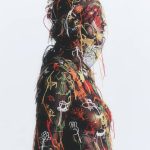From Vivienne Westwood to John Galliano to Azzedine Alaïa, the auction
of pieces from the collection of Sylvie Grumbach, founder of the press
office 2e Bureau, entitled “From the avant-garde to today”, is an
opportunity to revisit her past. Through her story, a whole era of fashion
comes to the forefront, with its variables (Paris’ place in fashion) and
its intangibles (the evolution of our consumer society). FashionUnited
spoke to Grumbach on her experiences in the fashion industry and memories
from her career.
How did your relationship with Vivienne Westwood come about?
I first met Vivienne Westwood at Le Palace in 1980. She was with Malcolm
McLaren, a manager of British bands. At the time, the London boutique
World’s End was already open, dressing band members, punks and also the New
Romantics (a musical and clothing movement associated with New Wave).
In 1983, following the death of Fabrice Emaer, I left Le Palace and
opened my own press office, 2e Bureau*, with Vivienne Westwood, Swatch and
Jean-Paul Goude. That year, Vivienne Westwood decided to come to France.
Her first show was at Angelina (the patisserie on rue de Rivoli, next to
Paris’ Hôtel Meurice). Naturally, we were two hours late.
Well-established brands were already parading in Paris, but this was the
time when young international designers were arriving at Paris Fashion
Week, a phenomenon initiated by Créateurs & Industriels. Vivienne Westwood
realised that showing in Paris would give her an international image and
help her to market in America.
How do you explain the popularity of the Paris catwalk?
Paris has become the capital of fashion thanks to Couture, which is a
French excellence.
Can you tell us a story about working with Vivienne Westwood?
I was in charge of a travelling fashion photography festival held in
Monaco. Vivienne was on the jury. We walked around Monte Carlo arm in arm.
She was dressed as we know her and wearing platforms. I myself was dressed
like Vivienne Westwood too: a big pink trench coat and Jean-Paul Gaultier
platform tennis shoes. We were banned from the casino.
Where did you meet John Galliano?
In London, I went to his graduation show (Central Saint Martin School,
1984, inspired by the Directoire’s ‘Incroyables’). It was so great that I
told him if he wanted to come to Paris, I’d be delighted to look after
him.
I was looking after Vivienne Westwood at the time. John had a great
admiration for her; he dressed in her clothes. Like all the younger
generations, he probably wanted to surpass her. I remember scenes where
John would sit at Vivienne’s feet to listen to her. They share the same way
of telling a story in their fashion shows. Both are very English.
Spotlight.
He launched his brand thanks to an English investor. He did two or three
shows in Paris, then went back to England. Their story ended badly because,
obviously, the return on investment wasn’t quick enough. He came to Paris
with his assistant without a penny to his name. Mind you, Vivienne didn’t
have any money either.
How was he able to develop collections without money?
He had the support of Anna Wintour, then editor of Vogue GB. Everyone
thought he was brilliant and he was endorsed by Fayçal Amor (Plein Sud),
who opened his workshops on Rue Servan (Paris) and gave him a space. He
supported him from the moment he arrived until he met Bernard Arnault,
orchestrated by Anna Wintour and André Leon Talley.
What do you remember about John Galliano?
When he arrived, he was a bit like Cédric, a Little Lord Fauntleroy
(excessively polite and well-dressed). He was very elegant and handsome.
Obviously, when you see how he’s transformed, it’s a bit sad. We were very
close, I could almost say that I fed him when he started out in Paris, he
liked my soup a lot in fact.
With Philippe Pasquet (formerly of Première Vision, now GL Events), we
organised a four-day fashion cruise in the Fjords. 400 people from the
fashion world (manufacturers, institutions, designers and couturiers) came
on board. There were conferences, stopovers, film screenings, a new
exhibition every evening, and so on.
The young designers of the day included Vivienne, John, Jean Colonna,
Olivier Guillemin and others. It was June, it was daylight 24 hours a day,
and the young people danced the night away on the bridge. On the last
night, John was so scared he wouldn’t wake up that he fell asleep on the
piano, which sat in the middle of the boat, so we wouldn’t forget him.
Were you close to Azzedine Alaïa?
I met Azzedine Alaïa through Andrée Putman, in 1978. After that, I wore
his suits and jersey dresses every day. At the time, he hadn’t yet designed
what I call his ‘skater dress’. I didn’t work with him until late. He used
to parade outside the calendar and would ask me, from time to time and on a
friendly basis, to help him with organisational matters. He didn’t need a
press office, he had everything he wanted. One day, Didier Grumbach (then
President of the Fédération Française de la Couture, du Prêt-à-Porter des
Couturiers et des Créateurs de Mode) asked him to appear in the official
Couture calendar. He accepted.
Azzedine Alaïa was a friend. He spent all his nights at his sewing
table, but from time to time he would come to the party. He liked to have
fun and went out a lot. I met him at Le Palace with Grace Jones. Of course,
he didn’t dance in the middle of the dance floor.
Could you explain why he stayed on the fringes of the fashion
system?
He always lived at his own pace. He wanted to show his clothes when he
thought that they were definitely finished. He would cut the first models,
do fittings, make patterns and so on. He was more or less alone. Today,
there are a lot of dressmakers who don’t know how to sew.
Do you have an anecdote with Azzedine Alaïa?
With him, personally, no. With one of his dresses, yes. I often wore
this famous black jersey dress with zips that went round the figure. It was
knee-length. It had a funnel neck at the front, but enough cleavage at the
back for someone to run their hand down my back. Every time I wore that
dress, everyone complimented me on how pretty I looked that night.
One day, I lent this dress to a friend. We were at Le Palace bar, and
people came up to her and complimented her in the same way. I realised that
it was the dress that attracted them and not me.
Are the outfits you are offering in your auction (which runs until
Thursday 7 September 2023 on Drouot Digital) from your personal
collection*?
Some of them I’ve worn, and others I’ve seen on the catwalk. At the
time, a lot of designers didn’t look after their archives, didn’t have a
venue and, very often, we didn’t get paid. Fortunately, I had a few clients
who allowed me to be a fashion patron. I kept these archives, either as
compensation or because the designers didn’t care about them.
Why are you parting with these material memories?
The first 15 years of the 2nd Bureau were spent in an attic in the
countryside, in Faverolles, which we are in the process of converting into
a foundation for the creative arts and fashion industries. The clothing
library has been transformed into a library of books.
Are you feeling nostalgic?
Yes, firstly because many of the trades didn’t exist and we were very
close to the designers. They were their own masters, setting up their own
companies. They hoped to earn money and make a living from their craft, but
their creativity was not muzzled. Today, we’re all dependent on marketing
and sales. What’s more, I think the street has become very ugly. Sportswear
is made for sports.
*Before opening her press office, Deuxième Bureau, Sylvie Grumbach
already worked in fashion: Valentino, Ungaro, Créateurs &
Industriels.
*The pieces in the “From the Avant-Garde to Today” auction (Drouot
Digital, until 7 September 2023) are by Vivienne Westwood, John Galliano
and Azzedine Alaïa, as well as Jean Paul Gaultier, Kenzo, Jean Paul Knott,
Kenta Matsushige, Claude Montana, Thierry Mugler, Saint Laurent Rive Gauche
and Koji Tatsuno.
This article originally appeared on
Translation and edit by: Rachel Douglass.



